| | Introduction | Fate of nutrients in manure | Case study: research plots at the Lethbridge Research Station | Conclusion | References
Introduction
A nutrient is defined as “a substance that provides nourishment essential for life and growth” and is origin from Latin nutrire, ‘to nourish’.
A contaminant is defined as “any physical, chemical, biological, or radiological substance causing an impurity in the environment”.
Substances such as nitrate (NO3) and phosphate (PO4) can be either nutrients to crop or contaminants for water. In other words, when nutrients end up in unintended target areas, they become contaminants. It is important therefore to determine the fate of a nutrient regardless of its source. In this article, we will focus on nutrients in manure.
Historically, animal manure was an important nutrient source for crop production. With the development of inorganic fertilizers, the importance of animal manure for crop production has diminished. Under modern intensified animal production systems, manure is considered as a waste by-product, which has resulted in it generally being perceived negatively. In recent years, this negative perception has extended to include intensive livestock production systems as a whole.
The potential for cattle manure from intensive feeding facilities to recycle plant nutrients, build soil quality, and increase crop productivity, especially for eroded soils, is well established (Chang et al., 1994; Sommerfeldt et al., 1988). There is however a concern that excessive application of feedlot and other types of animal manure to the land may have negative impacts as a result of nutrients and other elements accumulating in the soil (Chang et al., 1995; Chang and Entz, 1996; Chang and Janzen, 1994, 1996, Hao and Chang 2002; Hao et al., 2003). It is important then to better understand the fate of nutrients in animal manure throughout the whole production system in order to design beneficial management practices (BMPs) to reduce risk to environmental quality.
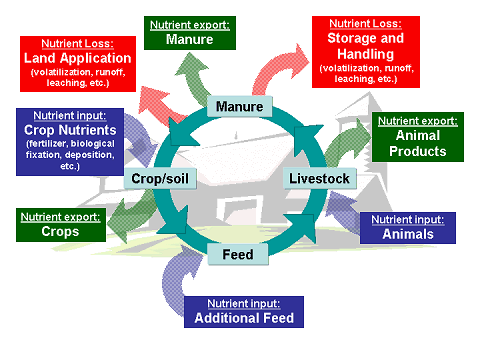
Figure 1. Conceptual overview of nutrient inputs, exports and losses in the on-farm nutrient cycle.
Nutrients can be lost from manure at several points in the manure handling system, such as from manure collection areas and storage facilities, during transfer to the storage facility, during manure treatment (e.g., composting), during land application and from the soil after land application.
The objective of nutrient management of any farm should be to balance nutrient inputs with projected outputs. Ideally outputs would consist of the marketable crop, animal products (e.g., live animals, milk, etc.) and manure export. Due to the biological limitations and inefficiencies inherent to crop and animal production systems, this objective is impossible to achieve in a practical context. The two critical points during the on-farm nutrient cycle where manure nutrients are most likely to be lost are:
- from manure storage and handling facilities; and,
- during land application operations.
Fate of Nutrients in Manure
Manure in feeding, storage and handling facilities
Nutrients in animal manure in feeding and storage facilities are lost to the environment through volatilization, leaching, runoff, and erosion. The proportional loss from each pathway will depend on the type of facility(ies) and climatic conditions. Much of the nitrogen lost from manure happens typically through volatilization as NH3 and volatile amines. Nitrogenous compounds in the manure can also be transformed by several biochemical processes into nitrogen (N2), nitrous oxide (N2O) and other oxidized nitrogen compounds (NOx), all of which are gasses that are lost to the atmosphere.
In southern Alberta, it is estimated that 50% of the total nitrogen excreted by cattle in open feedlots is lost before manure is removed from the pen through volatilization of NH3 and other gas emissions. In high precipitation areas, nutrient losses tend to occur more as a result of leaching, runoff and erosion. The amount of nutrient lost as a result of these processes is dependent on the characteristics of the facility itself. The measurement and control of those losses in feeding and storage facilities are relatively easier than those after manure applied to the land.
The environmental impact of nutrient movements as a result of volatilization, leaching, runoff or other processes will depend on where these nutrients end up. Nutrients can end up in the atmosphere or in neighbouring fields, ditches, and surface water and groundwater bodies.
Land applied manure
Manure contains a wide range of plant nutrients, but is also a complex mixture of various organic and inorganic compounds. Consequently, proper management of manure application to land is much more complicated than inorganic fertilizer. Nutrient concentrations in manure are typically very low, and most nutrients exist in several chemical forms. For example, manure contains both organic and inorganic nitrogen. Inorganic nitrogen is generally readily available for crop uptake, while organic nitrogen has to undergo mineralization, where it is converted to inorganic nitrogen before it can be used efficiently by plants. To further complicate the situation, the proportion of nutrients in the manure typically does not match those required by the plant. For instance, the N:P ratio in manure is generally in the range of 2 to 3, whereas the a crop such as barley requires these nutrient in a ratio between 7 and 10. As such, if manure is applied at a rate intended to meet plant N requirements, P will be over-applied. Repeating manure applications at the same rate to meet plant N requirement over the course of several crop years will result in P accumulating in the soil, thereby creating a potential for P pollution of surface and groundwater to occur. Figure 2 illustrates the modes of nutrient loss that can occur after manure has been land applied.
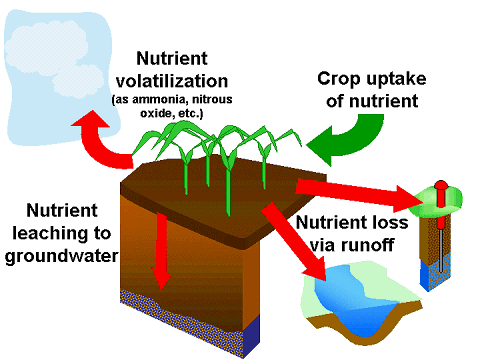
Figure 2. Possible fates for land applied manure nutrients
Case Study: Research Plots at the Lethbridge Research Station
Land application is still the best, most economical way to utilize manure since it returns manure nutrients to the farm nutrient cycle. Research on land application of feedlot cattle manure has been carried at Lethbridge Research Centre over 25 years to study the effects of heavy manure application on soil, water and air quality as well as crop production. Solid feedlot manure has been applied annually since 1973 at four rates to a well-drained, Dark Brown Chernozemic, clay loam soil seeded to barley, corn, canola and triticale. The sites have received manure at rates of 0, 30, 60 and 90 Mg ha-1 y-1 for non-irrigated land, and 0, 60, 120, and 180 Mg ha-1 y-1 (wet weight) for irrigated land. These rates are equivalent to zero, one, two, and three times the recommended maximum rates, respectively (Alberta Agriculture, 1980).
Crop yields
For non-irrigated land at high application rates, average barley grain yields decrease with increasing levels of manure application. Straw yields from the 30 Mg ha-1 y-1 treatment were higher than from control plots, but increased manure rates (60 and 90 Mg h-1 y-1) did not increase yields further. Under irrigated conditions, both barley grain and straw yields were higher in plots that received manure. Grain yields however decreased, while straw yields were unchanged at manure rates higher than 60 Mg ha-1 y-1. The protein content of barley grain increased significantly with manure application under both irrigation regimes (Chang et al. 1993). Other crops, such as corn and canola, showed similar yield results.
Soil properties
Soil surface physical and chemical properties changed significantly with long-term heavy manure application. The most noticeable changes in soil physical property were a decrease in soil bulk density, drawbar draft, and an increase in soil water holding capacity (Sommerfeldt and Chang 1985, Chang et al 1990). Increases in total organic matter, total nitrogen, available N, total phosphorous and available P (as well as other chemicals and elements) had a direct relationship to manure application rate (Sommerfeldt and Chang 1986, Sommerfeldt et al. 1988, Chang et al. 1990, Chang et al. 1991, Gao and Chang 1995, Dormaar and Chang 1995). Total N content in the surface 15-cm depth increased proportionally with cumulated total N applied through manure application (Figure 1) (Hao et al. 2003). The total N content of the surface soil reached as high as 0.8% after 25 year of annual application at a rate of 180 Mg ha-1 (initial total N content was 0.2%).
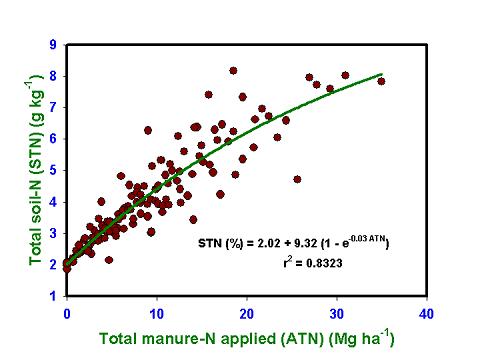
Figure 3. Total N content of 0-15 cm depth soil as a function of cumulated total N applied under both non-irrigated and irrigated conditions
Annual crops were unable to utilize all the available nitrogen provided by manure, even at the recommended rate of 30 Mg ha-1 y-1. Considerable accumulation of nitrate nitrogen (NO3-N) in the root zone of the soil was observed from 20 annual manure applications at 30 Mg ha-1 y-1 and nitrate accumulation reached to as high as 4.2 Mg ha-1 at application rate of 90 Mg ha-1 y-1 (Fig. 2) (Chang and Janzen 1996). Although the amount of nitrogen applied was much higher under irrigated conditions compared to non-irrigated conditions, the amount of nitrate accumulation was much smaller. This could be attributed to higher crop uptake, denitrification and leaching losses.
Total P content in the surface soil also increased with manure application rate (Chang et al. 1991) and the increase followed a similar pattern to that of total N content. After 20 years of annual manure application at a rate of 180 Mg ha-1, available P in the surface 15 cm soil reached to near 2000 kg-P ha-1 (Figure 3). Phosphorous did not move as ready as nitrogen, however available P in the 120 to 150 cm soil depth interval increased from 6 ppm in the check plot to 45 ppm in 180 kg ha-1 y-1 plots. These results demonstrated that P is available to move in calcareous soil.
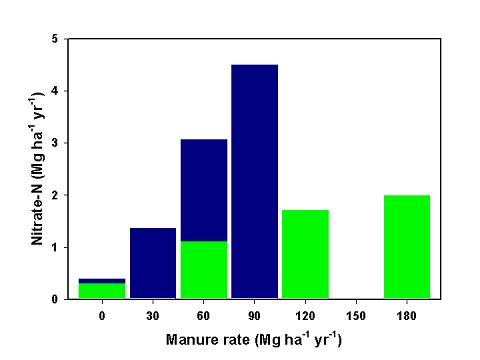
Figure 4. Total nitrate content in 0 – 150 cm depth soil after 20-year annual manure application (dark bar represents non-irrigated, light bar represents irrigated)
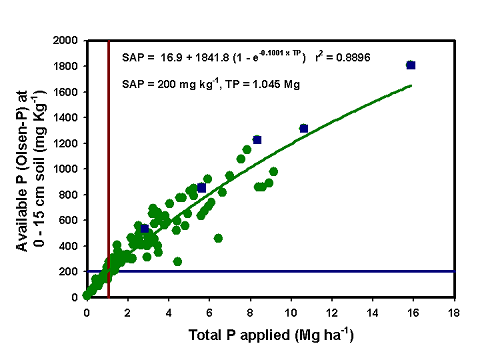
Figure 5. Available P content of surface soil increased with cumulated total P applied through annual manure application
Salinity of the soil profile also increased with long-term heavy feedlot cattle manure application (Figure 4a and 4b). Again the increase in soil salinity was smaller under irrigated than under non-irrigated conditions, which is mainly due to high leaching loss of soluble salts under irrigated compared to non-irrigated conditions. High soil salinity in the subsoil with high long-term manure application under non-irrigated conditions could have negative impacts on crop yield, and the high soluble salt leaching loss to shallow groundwater would have undesirable impact on groundwater quality.
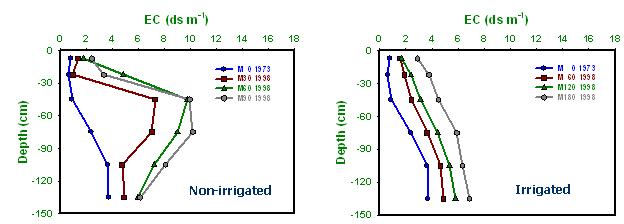
Figure 6. Soil salinity profile after 25 annual heavy feedlot cattle manure applications
Groundwater quality
Leaching loss of NO3-N is evidently a problem under irrigated conditions in southern Alberta. After 5 years of annual manure application, the estimated leaching losses of NO3-N from the root zone were 98, 220 and 344 kg of N ha-1 y-1 for the 60, 120 and 180 Mg ha-1 y-1 manure application rates, respectively (Chang and Entz 1996). The NO3-N content of shallow water table increased with time and reached as high as 750 ppm N during irrigation season. In order to achieve zero leaching losses of NO3-N while maintaining sufficient supplies of N for barley, manure should be applied at a rate of 14 Mg ha-1 y-1 (Chang and Entz 1996).
Air quality
After 20 years of heavy manure application, the soil emitted 0.7, 11, 23 and 56 kg-N ha-1 y-1 of N2O for application rates of 0, 60, 120 and 180 Mg ha-1, respectively (Chang et al. 1998). Nitrous oxide is not only a potent greenhouse gas, but also depletes the ozone layer of the stratosphere.
Conclusion
The results of our long-term study show that in order to avoid serious environmental quality concerns, manure should be applied at rates that reflect crop nutrient requirements. Long term experiments have demonstrated that repeated applications of manure at rates that exceed nutrient requirements of the crop result in nutrient build-up and shifts in salinity in the soil profile, and sets the stage for large scale contamination of surface and groundwater resources.
In order for intensive livestock production systems to be sustainable over the long term, producers must meet the challenges associated with managing the manure output from these operations. Specifically, the focus must be on matching inputs to outputs and optimizing nutrient cycling at the field level, as well as reducing preventable losses of nutrients to the environment.
References
Chang C, T.G. Sommerfeldt, and T. Entz. 1990. Rates of soil chemical changes with eleven annual applications of cattle feedlot manure. Can. J. Soil Sci. 70: 673-681.
Chang C, T.G. Sommerfeldt, and T. Entz. 1991. Soil chemistry after eleven annual application of cattle feedlot manure. Environ. Qual. J. 20: 475-480.
Chang C, T.G. Sommerfeldt, and T. Entz. 1993. Barley performance under heavy application of cattle feedlot manure. Agron. J. 85: 1013-1018.
Chang C, H.H. Janzen, and T. Entz. 1994. Long-term manure application effects on nutrient uptake by barley. Can. J. Plant Sci. 74: 327-330.
Chang, C and T. Entz. 1996. Nitrate leaching losses under repeated cattle feedlot manure applications in southern Alberta. J. Environ. Qual. 25: 145-153.
Gao, G and C. Chang. 1996. Changes in CEC and particle size distribution of soils associated with long-term annual applications of cattle feedlot manure. Soil Sci. 161: 115-120.
Chang, C. and H.H. Janzen. 1996. Long-term fate of nitrogen from annual feedlot manure applications. J. Environ. Qual. 25: 785-790.
Chang, C, C.M. Cho and H.H. Janzen. 1998. Nitrous oxide emission from long term manured soils. Soil Sci. Soc. Am. J. (in press).
Dormaar, J.F. and C. Chang. 1995. Effect of twenty annual applications of excess feedlot manure on forms of soil phosphorus. Can. J. Soil Sci. 75: 507-512.
Hao, X, and C. Chang. 2002. Effect of 25 annual cattle manure applications on soluble and exchangeable cations in soil. Soil Science 168:126-134.
Hao, X., C. Chang, G.R. Travis and F. Zhang. 2003. Soil carbon and nitrogen response to 25 annual cattle manure application. J. Plant Nutr. Soil Sci. 166: (in press)
Sommerfeld, T.G. and C. Chang. 1985. Changes in soil properties under annual applications of feedlot manure and different tillage practices. Soil Sci. Soc. Am. J. 49: 984 987.
Sommerfeld, T.G. and C. Chang. 1987. Soil water properties as affected by twelve annual applications of cattle feedlot manure. Am. Soc. Soil Sci. J. 5l: 7 9.
Sommerfeld, T.G., C. Chang and T. Entz. 1988. Long term annual manure applications increase soil OM and nitrogen, decrease C:N ratio. Soil Soc. Am. J. 52: 1668 1672.
Chi Chang and Xiying Hao
Lethbridge Research Centre, Agriculture and Agri-food Canada, Lethbridge, AB
Tel: 403-317-2220
Email: chang@agr.gc.ca |
|